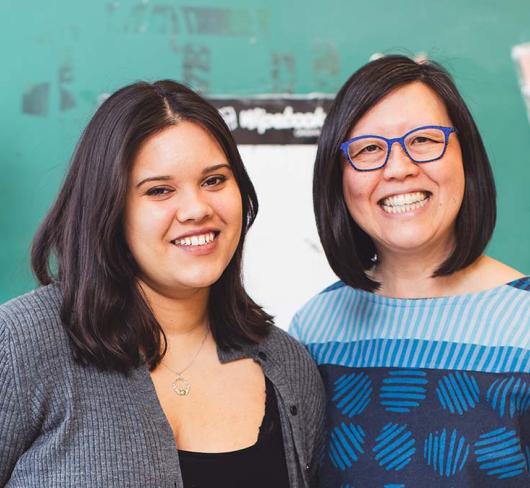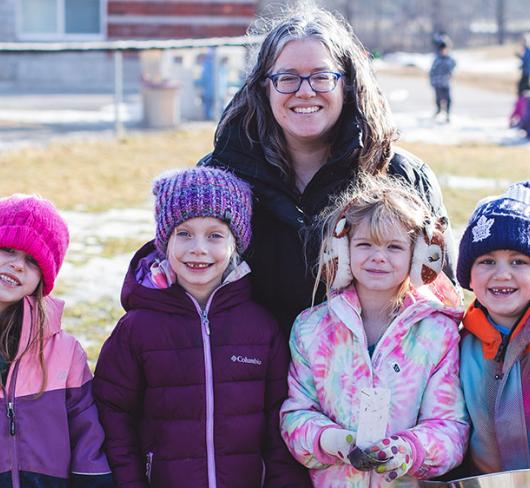
Growing Up Green
Every year students and staff look forward to watching the atrium at Alma School come alive with green as several varieties of trees sprout from seeds planted by students. The Upper Grand school stands proudly among three Ontario schools that fly an Earth II banner. Alma School participates in the SEEDS Foundation Green Schools project, first introduced to Canadian schools 30 years ago.
Designed to encourage students to be environ- mentally responsible and take personal action at school and with their families, the Green Schools Program recognizes schools for completing environmental projects, anywhere from 20 projects for Bronze to 3,000 for Earth III status. To date, only one school in Canada has reached Earth III, while the number of Earth II schools with 2,000 projects recently rose to 11. There are 244 Earth I schools.
Tree planting is one such project. Once they are hardy enough, Alma’s seedlings will be taken to a local nursery to mature for future planting in the community. If a single tree had been planted for each Green Schools project completed in the past 30 years, a forest of over 600,000 trees would currently be growing coast to coast. More impressive than imagining such a gigantic canopy of green is the idea that a new generation of teachers and students appears to be taking up the challenge. Protecting the legacy left behind by former students and retired teachers, junior environmentalists continue to embrace old projects while building a vision of their own.
Like growing trees, achieving such ambitious milestones takes time. Only a select few reach the top. “It took Alma 10 years to reach Earth II. There were many, many projects along the way,” said Sarah-Jane Olszewski, Alma’s kindergarten teacher/librarian.
There are challenges
Staff turnover was one of the school’s biggest challenges. “We reached Green status with 250 projects in 1992. Gord Black was the driving force behind achieving Earth status, until he retired. Then Lee Wilson took up the challenge of leading us to Earth II status,” said Olszewski. Wilson has now also retired. “We try to live up to our Earth II by remembering the “little” things like asking staff and parents to ‘lug a mug’ instead of using Styrofoam. We want to pick it up again, but new teachers, programs, and ideas keep us busy,” Olszewski said.
Alma’s principal, Randal Wagner, supports his school’s focus on the environment. “I don’t think the goal is to become an Earth School. I think the aim should be to become environmentally friendly because it’s the right thing for a school community to do. If the Earth School designation becomes part of that, then that’s great. In future, I think we’ll try to do a number of small projects as we work toward Earth III.”
The grade 6 class will plant one of the trees it raised from seed as part of their graduation ceremony this spring, a lasting legacy of their formative years at Alma. Grade 3 teacher Ian Eastmure took advantage of carryover opportunities by having his class write thank you letters to land owners who allowed tree planting on their property. “There’s lots of carryover between what we do outdoors and what we study in the classroom. We link with core curriculum in science, math, and language.” Other schools across the province following Alma’s example note similar problems with staff turnover, but find that once a school is hooked on the program advancing toward the next goal is a wonderful way to encourage a sense of pride.
Perseverance pays off
Concord Public School in Windsor reached Earth I status about three years ago under the leadership of recently retired teacher Ian Naisbitt (Naisbitt received 2006 ETFO Humanitarian Award for a Non-member). As grade 6 teacher and environmental club leader, Dave Vial does his best to take up where Naisbitt left off, with tree planting and recycling as a focus. He hopes one day to have a tree nursery for students to grow trees from seed for transplant in the community, similar to Alma’s project.
“Essex County doesn’t have very many trees to alleviate our poor air quality. Our senior students watched An Inconvenient Truth, the Al Gore documentary about global warming. They now have a deeper understanding how their tree planting can help make a difference,” commented Vial. “Concord is branded environmentally friendly,” said principal Ken Adams. “We’re working toward 2,000 projects because there aren’t many schools that have done that.”
The Greater Essex County District School Board is in the second phase of participating in Eco Schools.* This initiative, launched in 2006, helped the board lower its utility costs and includes everything from improving its buildings to turning off lights and computers at the end of the day. “Our focus on saving energy by turning off lights and computers is now shifting to reducing waste materials. Everyone from JK to grade 8 participates,” Adams said.
About to be twinned with neighbouring Princess Anne Elementary in a new building, Concord won’t have to leave its accomplishments behind. It is fifth in a series of theme-based schools the board is constructing.
“Both Princess Anne and Concord have a history of environmental and healthy living activism. The environment is one of the themes under consideration for the new school. Part of what we’re looking at is incorporating cutting-edge conservation into the building itself,” said GECDSB Director Mary Jean Gallagher.
If the new school’s construction does incorporate energy-saving measures and experiments with such things as a green roof, the combined student body could be on its way to achieving Earth II ahead of schedule.
Some of Alma School’s environmental projects
- planting trees
- building birdhouses
- bake sales to adopt endangered species,
- composting
- recycling
- litterless lunch days
- SEEDS bird tally family project
- energy home scavenger hunt
- making paper
- outings to nature centres and animal sanctuaries
- garbage Pitch-In days
- making snowmen with food for birds and animals
* For information about the Eco Schools program go to ecoschools.tdsb.on.ca.

